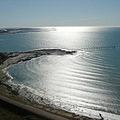 阿根廷政府通過國內第一座海岸公園,這是該國第一個野生動物覓食和向岸生殖群的法定保護區。
阿根廷政府通過國內第一座海岸公園,這是該國第一個野生動物覓食和向岸生殖群的法定保護區。
位於阿根廷南方丘布特省(Chubut province)的海岸公園於2008年12月正式成立,這個公園預計可保護50萬隻企鵝、數種稀有海鳥和該區特有的南美海獅(South American fur seals)。
這個公園的誕生得力於多個單位的合作,包括阿根廷國家公園管理處、丘布特省政府、以紐約布朗克斯動物園為主的野生動物保育協會和聯合國發展計畫及環球基金共同協助的當地組織巴塔哥尼亞基金會。
「這個公園的保護區是地球上最獨特且豐饒的海洋生態系之一。」野生動物保育協會阿根廷區主席哈瑞斯(Guillermo Harris)表示:「當漁業和能源業開始威脅當地許多物種的此刻,這個公園的設立正是一場及時雨。」
丘布特省長奈維斯(Mario Das Neves)說:「這個公園是古老的渴望,是個久遠的夢。不同於國內其他公園,它將守護包含鳥類的40種物種。」
公園位於聖喬治灣北方和首都布宜諾艾維斯南方1056英哩(1700公里),公園的保護區涵蓋250平方英哩(647平方公里)沿海區和鄰近約100英哩(160公里)海岸線。
這個區域有大約25萬隻麥哲倫企鵝棲息覓食,估計這個族群大約佔巴塔哥尼亞的1/4。
園區內50個小島組成南部信天翁的兩大棲地,佔巴塔哥尼亞沿海族群的八成;其他海岸物種包括瀕危的大西洋鷗(Olrog’s gull)、丘布特船鴨、和阿根廷將近1/3的藍眼鸕鷀和麥哲倫鸕鷀。
野生動物保育協會的研究人員和巴塔哥尼亞基金會合作,提供研究數據確認公園面積涵蓋向岸區和附近水域,研究員還發現,在漁業和石油業節節進逼下,該區物種亟待保育。
儘管園內海岸線仍未開發,野生動物卻已受商業捕魚威脅,因海鳥可能在覓食時纏入魚網。
沿岸鑿油井工業和從南巴塔哥尼亞運往布宜諾艾維斯的油輪所造成的油污染,同樣威脅野生生動物。
2008年1月,能源公司PAE(Pan American Energy)公佈在丘布特省發現一個大油田,估計每年可供應8千萬到1億桶原油,是目前該省產量的兩倍之多,也是必增加該區野生物種的生存壓力。
野生動物保育協會自1960年代便在巴塔哥尼亞進行物種保育研究,對象包括南露脊鯨(southern right whales)、麥哲倫企鵝、南象海豹和其他特殊物種。
該協會也在火地島(Tierra del Fuego)靠近智利那側規劃74萬英畝的保護區—主要是高盛集團在2004年所捐獻。
三菱汽車美國廠基金會提供沿岸保護區的成立經費,和贊助野生動物保育協會保護巴塔哥尼亞的計畫。
A new coastal marine park signed into law by the government of Argentina is the first protected area in the country designed to safeguard areas of ocean where wildlife feed as well as onshore breeding colonies.
The park in southern Argentina's Chubut province became official in December. It protects half a million penguins and several species of rare seabirds as well as the region's only population of South American fur seals.
The park's creation represents a joint effort by the National Parks Service of Argentina, Government of Chubut, and the Bronx Zoo-based Wildlife Conservation Society and its local partner Fundacion Patagonia Natural with support from the United Nations Development Programme and the Global Environment Facility.
"The park protects one of the most productive and extraordinary marine ecosystems on the planet," said Dr. Guillermo Harris, director of the Wildlife Conservation Society's Argentina Program. "The creation of this park comes in the nick of time for many species that are threatened by the region's fishing and energy industries."
"It is the realization of an old yearning, of a dream," said Chubut Governor Mario Das Neves. "It is different from other parks in Argentina, protecting 40 species in addition to the birds."
Located in the northern Golfo San Jorge, some 1,056 miles (1,700 kilometers) south of the Argentine capital of Buenos Aires, the protected area covers 250 square miles (647 square kilometers) of coastal waters and nearby islands along almost 100 miles (160 kilometers) of shoreline.
The region serves as a nesting and feeding ground for some quarter million pairs of Magellanic penguins, estimated to represent 25 percent of the entire population in Patagonia.
Its 50 small islands also support two nesting colonies of southern giant petrels that represent over 80 percent of its population on the entire Patagonian coast. Other denizens of this coastal oasis include the endangered Olrog's gull, the white-headed steamer duck, and almost one third of all imperial and rock cormorants of Argentina.
WCS researchers, working with Fundacion Patagonia Natural, provided critical data of key wildlife to ensure that the park's boundaries would include both onshore areas and adjacent waters. Researchers found that the area was in need of protection from increasing pressures by commercial fishing and the oil industry.
While the new park's coastline is still undeveloped, its wildlife has been increasingly threatened by commercial fishing nets, which can entangle birds as they feed.
The wildlife is also threatened by expanding offshore oil drilling and oil pollution from tankers sailing from southern Patagonia to Buenos Aires.
In January 2008, the discovery of a large new oil field in Chubut province was announced by the Anglo-Argentine company Pan American Energy. It is expected to provide an annual yield of between 80 million and 100 million barrels of crude oil, twice a much as the province produces today, increasing the pressure on the area's wildlife.
WCS has been active in Patagonia since the 1960s, conducting studies for the conservation of southern right whales, Magellanic penguins, southern elephant seals, and other unique wildlife.
The conservation organization manages some 740,000 acres of wilderness on the Chilean side of Tierra del Fuego, part of a major donation of land made by Goldman Sachs in 2004.
Mitsubishi Corporation Foundation for the Americas has provided funding for the creation of this coastal protected area and for WCS's multi-faceted efforts to safeguard coastal Patagonia.





